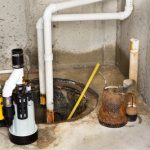The Difference Between Sump Pumps & Sewage Pumps

Definition and Purpose
First and foremost, let’s define each pump and understand their primary functions. A sump pump is typically installed in a basement or crawl space to remove water that accumulates due to rainwater or groundwater seepage into the building. Its purpose is to prevent flooding and water damage by pumping out the excess water and directing it away from the building’s foundation.
On the other hand, a sewage pump is specifically designed to handle solid wastes and wastewater from toilets, sinks, showers, and other household drains. It is commonly found in basements or areas where a building’s plumbing fixtures are located below the main sewer line or septic tank. Sewage pumps are responsible for grinding and pumping waste materials into the main sewer line or septic tank. Their primary purpose is to ensure the proper disposal of sewage and prevent backups and overflows within the plumbing system.
Composition and Design
Sump pumps and sewage pumps also differ in terms of their composition and design. Sump pumps are typically made of durable materials such as cast iron, stainless steel, or thermoplastic to withstand the corrosive nature of groundwater and other liquids. They are equipped with an impeller that spins rapidly to create a vacuum, allowing the water to flow into the pump and be discharged away from the building.
In contrast, sewage pumps are built with heavy-duty materials to handle the presence of solid waste and debris. They are made of cast iron or stainless steel to ensure durability and longevity. Sewage pumps have a grinder or macerator mechanism that breaks down solid waste particles, preventing clogs and obstructions within the plumbing system. Once the waste is broken down, the pump propels it through a discharge pipe, ensuring it reaches the final destination for proper disposal.
Installation and Placement
Sump pumps and sewage pumps also vary in terms of their installation and placement. Sump pumps are typically installed within a sump pit or basin, which is a hollowed-out space in the ground designed to collect water. The pump is placed at the bottom of the pit and is activated by a float switch or pressure sensor when the water level rises. It is crucial to position the sump pump at the lowest point of the basement or crawl space to effectively collect water and prevent flooding.
On the other hand, sewage pumps are usually installed in a sewage ejector system. This system consists of an underground sewage basin or tank where all the wastewater from the building’s plumbing fixtures is collected. The pump is then installed within the tank and activated by a float switch or pressure sensor. The sewage pump is responsible for grinding and pumping the wastewater from the basin into the main sewer line or septic tank. Proper placement of the sewage pump within the system is essential to ensure the efficient and controlled disposal of sewage.
Maintenance and Care
Both sump pumps and sewage pumps require regular maintenance and care to ensure their optimal performance. Sump pumps should be inspected periodically to check for any clogs or obstructions in the discharge pipe or the impeller. Additionally, the float switch or pressure sensor should be checked to ensure it is functioning correctly. It is crucial to keep the sump pit clean and free from debris to prevent any potential blockages.
Similarly, sewage pumps should be inspected and cleaned regularly to prevent the build-up of solid waste particles within the pump and the basin. The grinder or macerator mechanism should be checked for any signs of wear or damage and replaced as necessary. It is important to schedule routine maintenance with a professional plumber to ensure that the sewage pump is operating smoothly and efficiently.
Summary
While sump pumps and sewage pumps may have some similarities, they are distinct in terms of their purpose, composition, design, installation, and maintenance. Understanding these differences is crucial for choosing the correct pump for your specific plumbing needs. Whether you require a sump pump to protect your basement from flooding or a sewage pump to handle wastewater and sewage disposal, consulting with a plumbing professional is always recommended to determine the most suitable pump for your situation.
Need Septic Tank Services in Cleveland, TX?
Welcome to All Pro Septic! We are a family-owned and -operated septic tank cleaning business. We can install, repair, and maintain septic tanks for residential, commercial, and industrial properties. We also provide line cleaning, sewage pump repair, and clean grease traps, lint traps, and aerobic systems. We always offer free estimates to better your convenience. Do not let your septic tank stop you from wanting to use the restroom. Call us today and get a quote!
Categorised in: Sump Pump